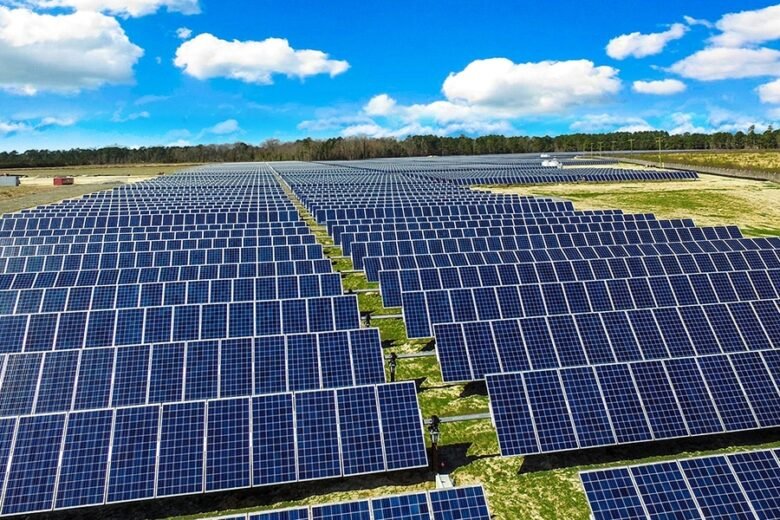Solar panels harness the inexhaustible power of the sun and turn it into clean energy, making these renewable, non-polluting systems essential weapons in our fight against climate change. Solar panel technology has increasingly become part of building designs, transforming rooftops and facades into energy producers that help maximize energy generation in densely populated areas while contributing to urban sustainability goals.
1. Renewable Energy Source
Solar energy is a sustainable form of renewable power, offering environmental advantages while eliminating dependency on fossil fuels and carbon emissions. Integrating solar panels into structures helps decrease grid power usage while still enabling buildings to run efficiently with no environmental harm done in their wake.
Photovoltaic cells use the photovoltaic effect to convert clean sunlight into electricity for powering our homes and offices, offering clean energy from an inexhaustible source. Available as monocrystalline (solid silicon) and polycrystalline varieties with thin film technology such as cadmium telluride/copper indium gallium selenide alternatives—often in tandem with battery storage solutions to further decrease dependence on fossil fuels—solar systems often come equipped with battery storage solutions as well, further decreasing fossil fuel dependency.
2. Energy Independence
Solar panels are an invaluable asset in helping our efforts towards carbon neutrality by cutting electricity bills. Integrating them into buildings turns them into energy producers, lessening our dependence on external grid power sources. Solar photovoltaic (PV) cells convert sunlight to electrical energy in an environmentally friendly process that doesn’t emit greenhouse gases, using virtually no water for cooling—an ideal choice for drought-prone regions.
Solar power allows countries to diversify their energy sources and decrease dependence on finite fossil fuels, which are often geopolitically unstable. Although solar energy relies on sunlight for power production, advances in energy storage technology may provide some backup during cloudy or nighttime conditions.
3. Reduced Carbon Footprint
Renewable solar panels do not emit any emissions during their entire lifecycle—providing another advantage over fossil-fuel generation methods. Although solar panel equipment produces some emissions, this is usually offset within several years by energy savings generated by its installation.
Solar panels are made from recyclable materials that reduce their environmental footprint, further lessening their impact. Furthermore, many installations feature pollinator-friendly habitats, which benefit wildlife as well as ecosystem health.
4. Reduced Energy Bills
Solar panels convert sunlight into energy that can either be stored in batteries or converted to alternating current electricity for use by appliances in your home. Solar panel efficiency is critical in controlling costs, since more efficient solar power systems produce more energy from less space. Thin-film cells using materials such as amorphous silicon and cadmium telluride on flexible substrates tend to be more cost-effective alternatives than their crystalline silicon counterparts.
However, it’s essential to carefully assess your property’s energy needs and the ability of grid-tied systems to sell any extra solar power back to utilities during peak hours or cloudy days.
5. Cleaner Air
Use of solar power for electricity generation can be a boon to the environment. By eliminating air pollution caused by burning fossil fuels, which contributes to respiratory illnesses in people and climate change, solar power becomes an environmental boon.
Solar panels utilize silicon cells that collect sunlight to knock electrons loose from their bonds and cause them to flow, creating electric current and creating energy, which is then collected and converted to AC current for home use. Solar panels have become an integral component of global efforts toward net zero emissions. While challenges still remain—including cost and access to skilled workers in remote regions—international cooperation is increasing.
6. Better Health
Solar panels turn an inexhaustible, free resource—the sun—into clean energy for homes or businesses. They do this by allowing photons from light waves to dislodge electrons from atoms, creating an electric current that powers homes or businesses.
Communities that switch to solar power reduce their reliance on fossil fuels and the emissions they produce, leading to cleaner air, healthier immune systems, and decreased rates of respiratory illnesses and other health conditions. Solar panels also produce minimal environmental impacts when running, meaning fewer healthcare costs and less stress on resources are incurred by their operation.
7. Increased Property Value
Solar panels have become an attractive feature of home ownership, with buyers willing to pay more for energy-efficient properties. Solar energy systems offer significant energy savings and reduce carbon emissions, helping future-proof homes. New technologies enable more creative solar installations, including integrating panels into building facades. Such stylish installations attract eco-conscious home and business owners while relieving pressure from city grids.
However, this increase will only occur if a homeowner owns their solar panel system instead of leasing it, so it is vital that individuals seek out a local NYC installation company with expertise in local permitting regulations as well as in designing systems tailored specifically to both aesthetics and energy needs.
8. Economic Development
Solar panels transform rooftops of homes, businesses, and other facilities into energy powerhouses. Their use contributes to global net zero emission goals while spurring economic development. Solar panel technology is continuously being refined to squeeze more power from every ray of sunshine. Recent advances have enhanced efficiency while decreasing production costs.
Utility-scale Solar projects create employment opportunities and contribute to tax revenue and infrastructure enhancements. Communities that welcome these initiatives become leaders in sustainability and economic prosperity; welcoming these projects may even attract new businesses or residents—especially important in remote locations where it may be costly to connect to the main electric grid.
9. Local Jobs
Large-scale solar projects create jobs and stimulate local economies, increasing tax revenue and driving infrastructure advances. Communities that embrace such initiatives become leaders in sustainability and economic prosperity.
Austin, where both state and city incentives support clean energy adoption, has seen solar industry leaders prioritize expanding opportunities for underrepresented groups through targeted training and apprenticeship programs that open doors for women and minority workers to take advantage of the industry’s new job growth while forging successful careers within it.




